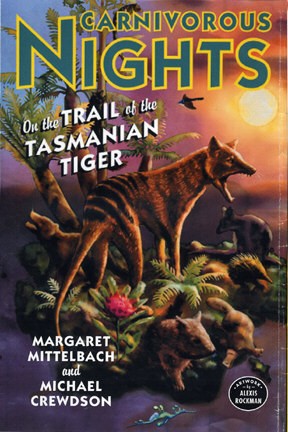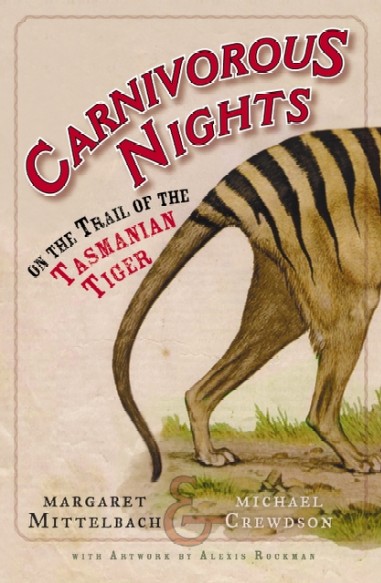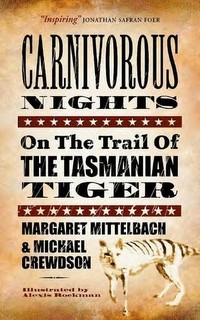Leap The CryptoHaiku Carnivorous
Posted by: Loren Coleman on April 12th, 2006
As Cryptomundo readers might recall, I named Carnivorous Nights: On the Trail of the Tasmanian Tiger, one of the "Top Cryptozoology Books" of last year, specifically bestowing it as "The Best Cryptozoological Expedition Book of 2005." The book is by Margaret Mittelbach and Michael Crewdson (with illustrations by Alexis Rockman).
The well-written record of three people tramping about on their quest is certainly an important volume for any cryptozoologist to read. For those especially interested in the Thylacine (a/k/a Tasmanian Tiger), of course, it is a must for your collection.
You might be able to win a free copy.
Now I’ve learned from the authors that they are conducting "A Beastly Haiku Contest," in conjunction with the launch of the paperback publication of their book.
All you have to do is write a haiku, e-mail it to them, and you could snag a signed copy of Carnivorous Nights: On the Trail of the Tasmanian Tiger (plus a copy of the book for your favorite library). Plus, they have a whole list of intriguing prizes.
What you have to do, according to the game rules, is pen an "original haiku about an extinct, endangered, or cryptozoological animal—or about an environmental problem like global warming or habitat destruction." E-mail it to them by May 22, 2006, and you could win.
Need an example of a haiku? MCA (a.k.a. Adam Yauch) of the Beastie Boys shared with them his own haiku. It’s about his favorite cryptid, the Sasquatch (with apparently an overlap into Yeti and others), and it goes something like this…
"Lady Mountweazel’s Lament" by Adam Yauch
sasquatch o sasquatch stricken down with crotch rot; BOOF! old yeti ya-ro
The inside scoop on the modern English shortened style of haiku is that it has three lines. The first line has five syllables, the second line has seven syllables, and the third line has five syllables, as per this construction:
5 syllables 7 syllables 5 syllables
Rhyming is not necessary, and actually may be seen as bad form by some haiku critics, but, heck, I like to play around with a combination of styles and here’s two samples of haikus I submitted to their contest:
"Me-Teh Weeping" by Loren Coleman
Not white, not alone The abominable one Yeti here, then gone
(April 10, 2006)
and
"Here, Not There" by Loren Coleman
Thylacine, not seen Don’t look in Tasmania Search west Australia
(April 12, 2006)
The contest is experiencing a shortage of cryptozoologically-related entries, so let’s help them out.
If you are interested, write about the Tasmanian tiger; extinct, endangered or any other cryptid or cryptozoological theme; endangered habitats; or anything "beastly," as they say. Then e-mail them your haiku, along with your name and contact info. Send your haiku to [email protected]
One grand-prize winner will receive a Tasmanian tiger prize pack, including: a Tasmanian tiger T-shirt, a jar of Tasmanian leatherwood honey (straight from the rain forest), a DVD of the "Howling III" featuring a Were-Tiger, a signed copy of Carnivorous Nights: On the Trail of the Tasmanian Tiger, and one signed copy of the book for the library of your choice. Five runners-up will each receive one signed copy of Carnivorous Nights and one copy each for your favorite library. Entries must be received by May 22, 2006. Winners will be chosen by their panel of judges and be posted on May 31, 2006. Entered haikus may be posted on their website. Copies of all these rules and prizes are to be found on their contest site.
As a side note, what I find fascinating about viewing their new paperback edition is that now there are three attractive covers available for Carnivorous Nights. I like the whole idea of bringing back the book cover as an art form, and in multiple versions.
Take a look.
The Unites States’ (and other countries’) hardcover edition has this well-known Alexis Rockman cover, in all of the spectacular colors of the Tasmania rainforest.

Also now newly available is the US paperback with the following cover of the back half of a Thylacine.
The Australian paperback has the same cover as the American version, as does the Canadian edition.

However, the UK paperback has a decidedly different front cover (below), that has a small Thylacine illustration and is text heavy. Interesting choice.

Cryptid haiku now. Leap into making beastly. Thylacines and more.
Enjoy.
About Loren Coleman
Loren Coleman is one of the world’s leading cryptozoologists, some say “the” leading living cryptozoologist. Certainly, he is acknowledged as the current living American researcher and writer who has most popularized cryptozoology in the late 20th and early 21st centuries.
Starting his fieldwork and investigations in 1960, after traveling and trekking extensively in pursuit of cryptozoological mysteries, Coleman began writing to share his experiences in 1969. An honorary member of Ivan T. Sanderson’s Society for the Investigation of the Unexplained in the 1970s, Coleman has been bestowed with similar honorary memberships of the North Idaho College Cryptozoology Club in 1983, and in subsequent years, that of the British Columbia Scientific Cryptozoology Club, CryptoSafari International, and other international organizations. He was also a Life Member and Benefactor of the International Society of Cryptozoology (now-defunct).
Loren Coleman’s daily blog, as a member of the Cryptomundo Team, served as an ongoing avenue of communication for the ever-growing body of cryptozoo news from 2005 through 2013. He returned as an infrequent contributor beginning Halloween week of 2015.
Coleman is the founder in 2003, and current director of the International Cryptozoology Museum in Portland, Maine.










Love those great haikus
I think I shall go for it
These are simple lines
These lines so simply
Illustrate complexity
It’s not hard to do!
And finally, from their WebSite…
Carnivorous Nights
A story of safari
gone slightly unhinged
Big Feet but no claws,
Eating other’s sandwiches
with biggest belches!
New book I want
Cool haiku that I did write
Win me Thylacine?
Well, the first was about Bigfoot and the other was beastly enough on its own!
Sasquatch bones linger
so briefly in deep gullies,
drumming human dreams.
I like haiku almost as much as I like cryptozoology. They both go good with wine and moonlight.
I like haiku too
So easy to verbalize
In a wine full tub
I must say, since this posting I have become strangly addicted to this Haikuzoo competition.
At first I was just dead-keen to win a prize, but subsequently I can’t stop myself coming up with new haikus.
It’s a strange artform. On the one hand I find it entirely frustrating because they’re so easy to write – so how do you tell a good haiku author from a bad one? Where’s the skill in haiku?
But on the other hand, they’re brilliant because they’re so easy to write!! hahaha. Even I can do it!
Can anyone post a link to an analysis of haiku as an artform?
If you haven’t entered already, the competition has a few days to go…
Chris.